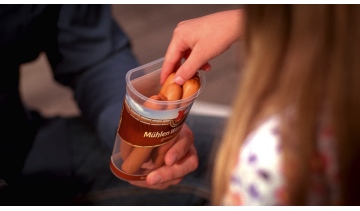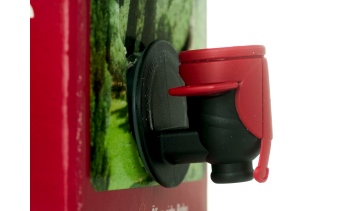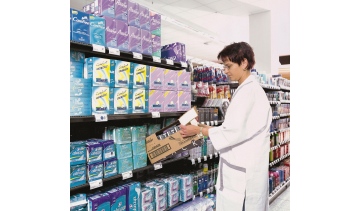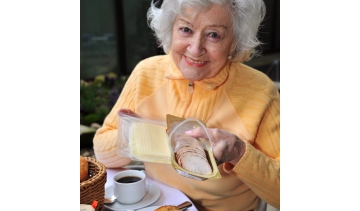

Packaged without broth, “Mühlen Würstchen” from Rügenwalder Mühle is also suitable for people on the go, thanks to its lightweight plastic package. (Image: Rügenwalder)
Many people love sausages. And, from to time, they also love to eat them with their fingers. At the same time, frankfurters and Vienna sausages are not exactly typical snacks for people on the go. In most cases, they are swimming in a broth or stick together in large packages.
The German sausage and ham specialist Rügenwalder Mühle now has the solution for snack-lovers. Since this October, the company is selling its Mühlen Würstchen sausages in a transparent, resealable plastic jar, that ensures the six little knackwurst sausages are guaranteed to stay fresh.
“People’s eating habits have changed fundamentally. The traditional three meals a day have now been superseded by several small and often fast snacks,” says Godo Röben, head of marketing at Rügenwalder Mühle.
There’s a current strong trend towards convenience products like Mühlen sausages. The packaging function is no longer for just protection, transportation and storage, but now also offers a functional extra benefit as well. “Straightforward handling of the product package is becoming more and more important for consumers,” explains Hilka Bergmann, head of packaging research at the EHI Retail Institute in Cologne.
Convenience features such as easy opening, resealability and portioning are thus becoming increasingly prominent in package design. Another approach is foods that can go straight into the microwave in their packages and thus simplify cooking. Packages with novel plastic laminates that extend a product’s “best-before date” also belong in this category.
Grey Power
The need for products with added value is being driven by demographic change. Within the industrialized Western nations, the the number of people who fall within the over-60 range continues to increase. It’s this range of consumers who are having a greater difficulty reading graphics and texts on packages and even opening the packages by hand.
According to a study by the German Federal Association of Organizations for the Elderly (BAGSO), older people have a particularly tough time with products welded in plastic – the tear tabs are often difficult to find and it takes a lot of effort to open the packages. This is why the elderly prefer easily recognizable and straightforward opening methods.
At the same time, people’s lifestyles are changing. All over the world, people are taking less time for meals, and snacks between meals and a quick espresso from the coffee machine have become very popular. A big hit, for instance, is chilled food, i.e. products like smoothies, antipasti and delicatessen salads, prepared fresh and in most cases kitchen-ready. The chilled food trend has its origins in the U.S. and came to Europe a few years ago. For industry, this is associated with a further challenge. The consumers of chilled foods are also often health-conscious and attach importance to naturalness, purity, freshness and tradition. Hilka Bergmann from EHI knows that modern consumers want products that look hand-made and as if packaged fresh at the counter.
Industry cannot ignore the needs of older, working and health-conscious people. Anyone who disregards convenience and whose products don’t stand out from the crowd with an attractive appearance and high functionality will soon not be able to compete on the highly competitive international market. In Germany alone, the convenience market, according to figures from the Munich market researchers USP market intelligence, comprises 560,000 points of sale and now has a sales potential of about EUR 30 billion – with an upward trend. “Convenience features are rated as important to very important by two thirds of consumers,” says USP analyst Katrin Waller. A particularly striking fact is that 34 per cent of the elderly buy a different product if they cannot cope with a package, according to results from the BAGSO study.
Competition for the classical can
In the battle for market shares, product manufacturers are therefore resorting increasingly to packages that communicate comfort and convenience to the consumer. In doing so, they rely on the creativity and expertise of package manufacturers and their suppliers. Rügenwalder, for instance, uses special plastic jars from the German Weidenhammer Packaging Group for its Mühlen sausages.

There is a trend towards packages with extra functional features. The STI Group has therefore developed its bag-in-box for edible oil on tap. (Image: STI Group)
In other food segments as well, the manufacturing specialist in composite cans and plastic packages contests the classical can packaging.
“Instead of tinplate or glass, it is plastic’s turn on supermarket shelves,” declares Ralf Weidenhammer, president of Weidenhammer noting the example of the PermaSafe plastics solution that securely packages sterilized and pasteurized foods in manner that still makes it much easier to handle and is lighter than conventional ring-pull cans.
The simple handling is made possible by an easily removed peel film and a lid for resealing. Product manufacturers have complete faith in this innovation. The German company Müller’s Hausmacher Wurst was the first customer to use PermaSafe, and further products are already planned. All the same, notwithstanding Weidenhammer’s plastic offensive, the classical can still has a strong future in the marketplace. Because of its good sealing characteristics and robustness, many product manufacturers continue to rely on this packaging solution with its decades of proven performance.
Another big topic for the Weidenhammer Packaging Group is the further development of the conventional composite can. At interpack 2011–a leading global trade fair for the packaging industry held May 12-18, 2011 at the fairgrounds in Düsseldorf, Germany–Weidenhammer will introduce a composite can with a peel-off top that also provides an extra-tight seal, it is suitable for such oxygen-sensitive foods as milk powder.
At the German company Wipak Walsrode, a subsidiary of the Finnish Wipak Group, there is a focus on innovation in film production and processing. Along with high-grade barrier films, their hallmark is natural-looking packages with a so-called “crumpled look”.
‘Back to nature’ is the motto of many manufacturers and retail chains who want to emphasize the high quality ideals of their products by means of packages made of paper compounds,” says spokesperson Astrid Reinke, noting that Wipak has developed a special production process for this.
During film production itself, paper is integrated in the film composite. Super-thin film layers are laminated on the inside of the package against the paper layer. The advantage of this is that the outside of the package has a paper feel, and the oxygen barrier and sealing functions required for protection and freshness are performed as usual by the layers of plastic. The unassuming stick of cheese marketed as the “Stangerl” by Bergader in Germany has become a big-selling product thanks to its new fresh look.
Back to nature
‘Simplicity and sustainability’, on the other hand, is the motto of the German display and packaging manufacturer STI Group at interpack 2011.
“Packaging solutions are now expected to feature convenience and a minimal ecological footprint,” states spokeswoman Claudia Rivinius. As a first step towards greater sustainability, STI develops its packaging for the food and consumer goods industry mainly using cardboard and corrugated board and largely dispensing with plastics. Familiar to many, the STI classic is the package of the Persil laundry detergent brand with its special tear-open function. The latest products of the specialist producer include a folded cardboard box for Osram energy-saving lamps. It contains a high proportion of recycled paper, has an organic shape to match that of the lamp, a large window and an open base. The package is therefore not only environment-friendly, but also makes the purchasing decision easier for consumers, enabling them test the lamp on a device installed in the shop without having to open the package.

Goods with easy handling characteristics that simplify the stocking of shelves are of great importance to the convenience-conscious retail industry. The packaging industry takes this into account as well. (Image: STI Group)
Critics now claim that the development and production of such packages is elaborate and expensive and ultimately increases the cost of the product. Industry, on the other hand, argues that costs are in fact reduced by savings in materials and ongoing improvements in production methods. This sounds plausible, because manufacturers of packaging machines are energetically pushing ahead with innovations. Ilapak, the Swiss machine manufacturer that now supplies twelve branches of industry in the food and non-food sectors, is currently launching turnkey packaging lines. The benefit is that the machines are perfectly adapted to each other, thus boosting efficiency. “With complete, single-source solutions, industry can cut its costs per packaged unit significantly,” promises Ilapak marketing manager Christian Romualdi.
Multivac, the German packaging designer and machine manufacturer, is also improving the efficiency of its lines. At interpack 2011, the company plans to present a deep-drawing packaging machine that consumes at least 20 percent less energy than conventional machines. Deep-drawing packaging machines are considered all-rounders, capable of packaging food and non-food items automatically.
“We save energy by replacing all the pneumatically driven subassemblies with highly efficient electric drive technology,” says Multivac sales manager Helmut Sparakowski.
But what has Multivac’s innovation got to do with convenience? Easier handling and durability have now been joined by sustainability as one of the biggest feel-good factors for consumers. They can therefore be expected to ask increasingly whether products have been manufactured according to resource-conserving principles.
For interpack 2011 press information, contact:
Anne Meerboth-Maltz
ameerboth@mdna.com
Tel. 312-781-5185
Advertisement


